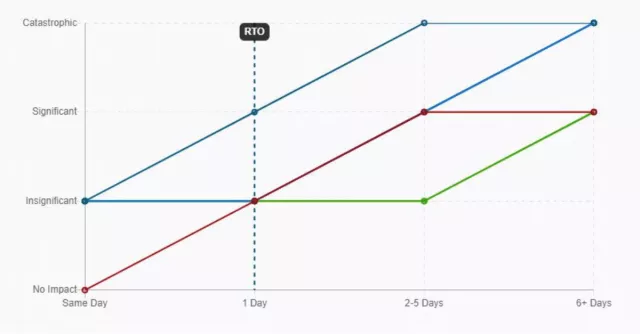How to Create a Business Continuity Plan in 4 Steps

Business interruptions happen without warning, so the worst-case scenario is to be completely unprepared. A well-defined business continuity plan can provide a lifeline and allow your organization to face the unexpected.
When news about hurricanes, wildfires, and earthquakes makes headlines, we tend to think of people and communities affected by these natural disasters. But how often does one think about the impact on businesses?
September is a National Preparedness Month. So we’d like to highlight the importance of proper disaster preparedness and business continuity (BCDR) for businesses.
Definition of Business Continuity
Business continuity is a process, plan, and procedures that identify potential risks and threats to an organization, estimate the impact of those risks to business operations, and provide the framework for establishing organizational resilience and preparedness.
Business continuity management consolidates such critical disciplines as incident management, emergency notification, disaster recovery, and business continuity.
The goal of a robust business continuity plan is to keep the fundamental processes of a company operational during a disaster and to reduce downtime. A business continuity plan may consider various scenarios, such as natural disasters, wildfires, cyberattacks, or an isolated incident. However, having a general outline of an action plan is important. It should include everyone involved in the crisis communication process and their responsibilities during a crisis.
Business continuity is critical for companies of any size. The cost of downtime for a small business can result in permanent closure. A larger business will not only be faced with hefty bills but also need to deal with reputational damage.
Business Continuity vs. Disaster Recovery: Understanding the Difference
Disaster recovery is a subdivision of business continuity. If the latter focuses more on preparedness and building resilience, disaster recovery planning aims to mitigate the post-failure processes and restore operations as quickly as possible following a disruption. Disaster recovery can involve managing various elements, such as data and physical recovery.
4 Steps to Business Continuity Planning
Business continuity planning is an ongoing process that may involve separate departments in designing a plan to address any potential crisis. Several steps can help in creating a solid business continuity plan.
1. Assessing and Prioritizing Potential Threats for a Business
As the initial stage of forming a disaster preparedness plan for your business, you need to identify which situations or events pose the most risk to it. Different scenarios may pose different threats to your business continuity, but they all can paralyze your processes.
Do you have secure protection against cyberattacks? Do you and your employees know what to do if there’s an active shooter situation in your office? Who is responsible for communication during an emergency?
Following the steps of a simple risk assessment plan can help you identify the probability of a certain threat and its impact on your business.
2. Creating a Disaster Preparedness Plan
The best way to create a dependable and organized plan is to have a designated person for this task. This person will be responsible for designing such a plan, but you, as a business owner, should specify what to include in it. Consider asking the following questions when you assign an important task.
- Does your business continuity specialist need a supporting team?
It’s helpful to have a team working on securing business continuity when it comes to large businesses with different departments. Each department has its unique processes and regulations; that’s why it’s crucial to eliminate the guesswork and have someone from each team represent their interests. Additionally, if you deal with any vendors or suppliers daily and consider them crucial to your operations, they should also be represented on your disaster preparedness team. - What’s the scope of your plan?
A good disaster preparedness plan aims to ensure your employees’ safety, the stability of your work location, and the continuity of your work processes. Defining the scope of your plan will help everyone involved to stay focused. The basic elements of a plan include:
- An evacuation plan.
- Crisis comms plan, detailing emergency contact information.
- Who’s responsible for shutting all equipment down or performing other essential final functions
- Any other special instructions
3. Implementing a Business Continuity Plan and Training Workforce
Once drafted, your business continuity/disaster recovery coordinator, the team, and you need to approve the plan. However, your involvement doesn’t end here. Contrary to common belief of what a disaster recovery plan is, it’s not meant to gather dust on a shelve. As soon as the plan is complete, you have many action items. The goal is to identify what can be done now before a crisis strikes.
Among the examples are some of the following materials:
- Emergency communication plan
- Emergency kit
- Training and testing exercises, such as tabletop exercises
All of your employees must be trained on how to evacuate the building, where to get information in case of emergency or business interruption, and how to access general safety information. Your business continuity team needs to be trained on their roles and responsibilities described in a plan. The same goes for your crisis communications team, which must be fully trained to develop specific messaging for different situations.
4. Refinement and Testing a Business Continuity Plan
No plan, regardless of how thorough it is, is worthless unless it’s regularly reviewed and updated. Your business is a continually evolving entity, so your disaster preparedness plan needs to adapt to your company’s needs at every step.
It’s important to remember that the question is not if, it is when the unexpected is going to come your way. Invest in devising your own disaster preparedness plan for the sake of business's longevity.


